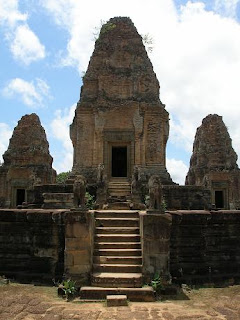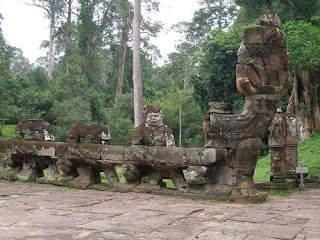
It's hard to believe that I'll be departing Southeast Asia for good in just 2 days.
Yesterday I had quite an experience in Kuala Lumpur, more commonly called KL. I met a Korean national at my hostel who was spending his last day in the city and wanted to go clubbing before his plane for Laos this morning, so I went along.
He had the name of a good club called Nuovo, but when we arrived at 10 p.m., they said that things get going there at about 11.30 and offered for us to come back later. We agreed, and in the meantime went to the bar/club adjacent to it. Then we went across the street to a club, but saw that there way too many lonely women there (read: hookers), so we went back to the club next door from Nuovo. I forgot the name, but it was all right for an hour. Then we attempted to go back to Nuovo, but even at 12 midnight it was slow there, so we asked the owners what a good Malaysian club is that's frequented by locals. They suggested Blue Boy.
Well, it was quite an experience. I should have thought about it earlier. After all, Blue Boy wouldn't be the name of a typical club. And it wasn't. It was a gay-friendly club, which we only discovered upon entering. First we saw a singing contest, and while the music was great, I realized that there were no girls in the club at all. Finally, I spotted a few, but upon closer observation, they were more likely to be ladyboys.
Quite an experience. It was my first time in such a place. And, in all places, in Kuala Lumpur, Malaysia, which is a Muslim-majority country. At least KL is contemporary, for I could not imagine the same thing, say, in Riyadh or even Qatar. But KL is different.
For one, KL, literally meaning "muddy estuary" in Malay, is mainly of Chinese descent. Indeed, some 55% of the city's residents are ethnic Chinese, which explains the omnipresent Chinese signage in the city. In this country of 27 million people, Chinese constitute about 27% of the population, with Indians comprising another 10%. While the country is some 60% Muslim, due to Malaysia's geographic location and demographics, it is "Muslim lite." It didn't even feel like Ramadan, since many of the food places are open during the day, as are many shops. Malaysia's minorities include Buddhists (some 20%), Christians (10%), and others.
The city KL itself is about 2 million people--with about 5 million more in the greater metropolitan area, so it's just a tad smaller than Chicago.
What was nice is that English is spoken by most locals. And spoken very well. Since Malaysia became an independent country only about 50 years ago, English is required in schools. Many older locals still remember it, while the younger generation learns it in school and the middle-aged know it for business. KL is a big financial center, too, boasting great infrastructure and architectural wonders, such as the Petronas Towers (pictured here). Alas, the picture isn't mine--it's from Wikipedia-- but the towers are an amazing feat.
After Cambodia, some differences are striking. The infrastructure here is many times better. There are most of the Western food and clothing chains, none of which, except KFC and Dairy Queen, I saw in Cambodia. And the food is different, too. After traveling around Southeast Asia for nearly a month, I have come to find one common ingredient in most locals dishes: rice. However, the way it is prepared is different from country to country. The Thai fry their rice and add curry to it, as do the Cambodians. The Cambodians, though, also eat sticky rice. Lao people, on the other hand, eat sticky, plain rice almost exclusively, as do the Vietnamese. Here in Malaysia it is fried with some chilis--and no lemongrass, as in Thailand. It has a tangy, bit spicy flavor to it and is not sticky at all. Out of all the rice I have tried, the rice here is probably my favorite.
I have also noticed about one other commonality: the widespread scourge of prostitution. It is everywhere, bar Singapore. I must have been stopped and offered a girl at least 10 times yesterday on my way to and from the club--and a massage at least 15 times. Even in Laos and Cambodia it's a similar situation, if a bit more tame. In Vietnam the pimps and/or hookers are super-aggresive, following foreigners on motorcycles. The difference is that in Thailand if it's officially illegal but the authorities turn a blind eye toward it (thereby indirectly, or directly, encouraging it), in communist countries such as Vietnam the police try to stamp it out, but it's not working. It's strange, indeed, for I had previously thought that only Thailand was a place where something like this is so widespread. I guess not. As long as Southeast Asia remains poor, it seems, despite the region's quick economic growth, prostitution will exist en masse.


























































